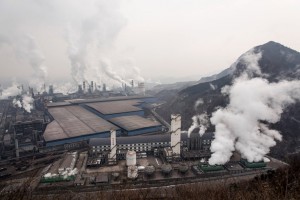Source: Sinosphere, NYT (12/16/16)
China Has Made Strides in Addressing Air Pollution, Environmentalist Says
By DIDI KIRSTEN TATLOW
In his offices in central Beijing on a recent afternoon, Ma Jun, the director of the Institute of Public and Environmental Affairs, a nongovernmental organization, moved his mouse over a computer screen showing a map of real-time air emissions from more than 4,600 Chinese factories. The red rectangles, one for each factory, overlapped one another like badly laid mosaic tiles.
In all, 270 factories across China were shown to be exceeding emissions on the map on the institute’s website, probably a fraction of the total number of polluting factories in China. But data itself is an improvement, he said.
Logging emissions is an important step in securing the transparency that China needs to solve its pollution problems, Mr. Ma argues. Among the harmful pollutants are air particles known as PM2.5, which can enter deep into the lungs and even into the bloodstream. In an interview, he talked about the considerable progress he sees in the Chinese government’s approach to air pollution, but also how concerns about social unrest continued to constrain discussion of pollution’s damage to public health.
Where do things stand today?
Before 2013, levels of PM2.5 [the finest and deadliest particulate matter] were not monitored or made public in a single city. Now it’s monitored and released in more than 400 cities. China has entered an era when air quality information is released. It’s much more transparent.
We see huge progress in tracking pollution sources. Ten years ago, in 2006, when we first started collecting such information, we could only get about 2,500 records of violations a year. Today, it’s more than 290,000.
Also, for the first time, in this 13th Five-Year Plan, the government has set a target for reducing PM2.5 particles in the air by 2020. It says it will reduce those by 18 percent in areas that exceed the threshold [of 35 micrograms per cubic meter].
The 11th and 12th Five-Year Plans only referred to “emission reduction targets,” so local governments could play games by claiming they had reduced emissions. Now, by saying by what year the PM2.5 must be below a certain amount, it’s much harder to fake. The 13th Five-Year Plan is a progressive plan because it says that the public has the right to participate, to monitor, and that it’s the public’s right to know.

Ma Jun, the director of the Institute of Public and Environmental AffairsCreditSkoll Foundation
How realistic are those goals?
The level has been declining gradually, but the difficult part is that now it’s regional pollution, not city pollution. For Beijing, if the regional problem is not solved, the wind will just bring it from Hebei Province.
The daily average PM2.5 acceptable in China is 75 [micrograms per cubic meter], above the maximum levels set by the United States and the World Health Organization. Even so, it’s difficult to reach that goal. Most cities in China can’t meet it.
Do you feel you have a good understanding about the impact the smog is having on people’s health?
There are figures of premature deaths caused by air pollution. Somestudies say about a million a year, and others say 300,000 to 500,000 a year.
There isn’t much research on the relation between air pollution and lung cancer in China, and even less with accessible research results. It’s sensitive. The government does not want to cause panic among the public.
Last weekend, the police broke up a small group of people wearing masks at an antipollution protest in the southwestern city of Chengdu. Then reports spread that some schools had told students and teachers not to wear masks and to trust the government to solve the problem. Is wearing antipollution masks illegal?
I think the government is not against people wearing masks, but if the masks become a sign of protest, then that’s another matter. I think the government didn’t mean to ban people from wearing masks in Chengdu but was afraid of the protest.
There’s growing pressure from parents for schools to install air purifiers. In Chengdu, some schools appeared to say that they would not do so and that, again, parents should trust the government to solve the problem. But is this something that should happen?
I think schools in Beijing had similar discussions whether classrooms should be equipped with air purifiers. Some schools didn’t want to use purifiers. But whether to equip the classrooms with air purifiers or not is also a technical issue. In some schools, old schools especially, the electrical systems can’t cope with so many air purifiers running at the same time. And I don’t think it would be affordable for the government.
You track the data and think about pollution all day long. Do you worry about your own health?
Of course. But I worry the most about my child. I think it’s the same for most parents in China. Before the index was public, even on smoggy days, my child ran around outdoors at school. I worried because I know how bad it was, but other parents didn’t know.
